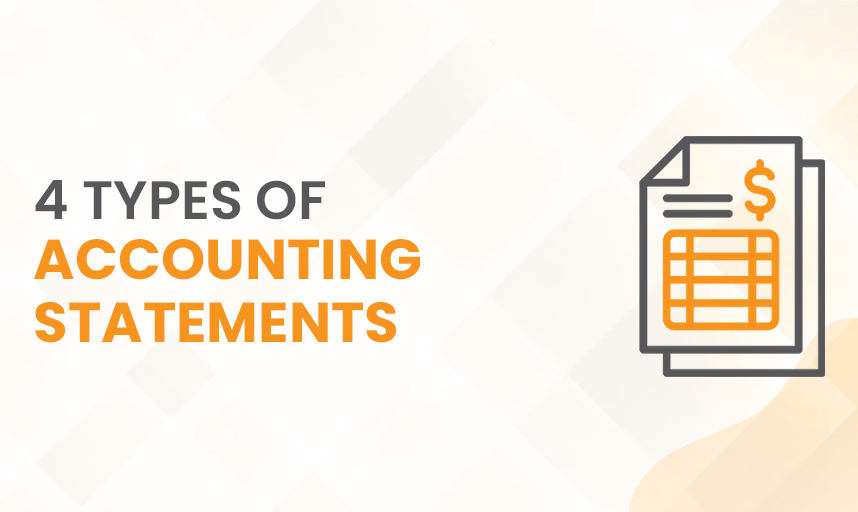Whether you are a small business or a business that is planning to expand you can’t resist creating accounting statements.
This blog will give insights into accounting statements that act as the backbone of any business.
Let’s check out the four primary types of accounting statements and what sort of information can be evaluated from these statements.
#1 Profit And Loss Statements
First, we have the Profit and Loss statement, which serves as a compass for companies, helping them manage profitability over predetermined timeframes. For business owners, it’s a strategic tool, highlighting areas of triumph and potential challenges, while investors use it as a gauge for sound investment decisions.
Key Functions:
- Directing focus and resources effectively for business owners.
- Providing investors with insights for informed investment decisions.
Revenue Section:
- Primary business activities (e.g., product sales and services).
- Secondary activities (e.g., bank interest).
- Other financial gains (e.g., profits from asset sales).
Expenses Section:
- Cost of goods sold (direct labour and materials).
- Operating expenses (indirect labour and production-unrelated costs).
Calculating Key Metrics:
- Gross Profit: Total revenue – cost of goods sold.
- Gross Profit Margin: (Gross profit ÷ total revenue) x 100.
- Operating Profit: Gross profit – operating expenses.
- Net Profit: Total revenue – (costs of goods sold + operating expenses + taxes and other expenses).
Example:
Consider a business with total revenue of $500,000, cost of goods sold at $200,000, operating expenses of $150,000 and taxes of $50,000.
Using the above formulas, these will be the results:
Gross Profit: $300,000 ($500,000 – $200,000)
Gross Profit Margin: 60% ($300,000 ÷ $500,000) x 100)
Operating Profit: $150,000 ($300,000 – $150,000)
Net Profit: $100,000 {$500,000 – ($200,000 + $150,000 + $50,000)}
#2 Balance Sheets
Next, we have is Balance Sheet, a comprehensive map of a business’s financial status at a specific point in time. It reveals what a business owns (assets) and owes (liabilities), with the difference representing the owner’s equity.
Key Components:
- Assets: Current assets, fixed assets, and intangible assets.
- Liabilities: Current liabilities and long-term liabilities.
- Formula: Owner’s Equity = Assets – Liabilities.
Example Scenario:
Consider a business with current assets of $300,000, fixed assets of $400,000, current liabilities of $150,000, and long-term liabilities of $200,000.
Then using the above formulas the results will be:
Total Assets: $700,000 ($300,000 + $400,000)
Total Liabilities: $350,000 ($150,000 + $200,000)
Owner’s Equity: $350,000 ($700,000 – $350,000)
#3 Statement Of Changes In Equity
Statement of Changes in Equity is where you get the story of a company’s equity evolution over a given time frame. It’s a vital tool for shareholders and investors, providing insights into how various business activities impact net worth.
Key Components:
- Opening Equity Balance: Equity at the start of the period.
- Comprehensive Income: Net profit or loss, other income and expenses.
- Owner Transactions: Changes in equity from interactions with owners.
- Closing Equity Balance: Final equity value after considering all factors.
Example Scenario:
Formula: Closing Equity Balance: Opening Equity + Comprehensive Income + Owner Transactions – Dividends
Calculations:
Closing Equity Balance: $1,020,000 ($800,000 + $200,000 + $50,000 – $30,000)
#4 Cash Flow Statements
Cash Flow Statement is a crucial document tracking the movement of cash into and out of a business over a specific period. It’s a beacon for business planning, indicating the ability to settle debts, purchase materials, and invest in assets.
Key Aspects:
Cash flow from operations, financing, and investing activities.
- Cash Flow from Operations: It shows the money flowing in and out from day-to-day activities, including sales, and how well you manage what’s owed to you and what you owe.
- Cash Flow from Financing: Cash flow from financing is about the money moving between your business and its owners or creditors. It includes getting funds from borrowing or issuing shares and paying them back, along with dividends and buying back shares.
- Cash Flow from Investing: Cash flow from investing is about your business’s long-term money decisions. It includes buying or selling things like property and equipment, reflecting your commitment to growth.
Example Scenario:
Consider a business with an opening cash balance of $80,000 have net cash flow from operations of $180,000, net cash flow from financing (inflow) of $20,000, and net cash flow from investing of -$30,000.
Formulas:
Total Net Cash Flow: Net Cash from Operations + Net Cash from Financing + Net Cash from Investing
Closing Cash Balance: Opening Cash + Total Net Cash Flow
Calculations:
Total Net Cash Flow: $170,000 {$180,000 + $20,000 +(- $30,000)}
Closing Cash Balance: $250,000 ($80,000 + $170,000)
Conclusion
Finally, we can say that we have a basic understanding of Profit and Loss statements, Balance Sheets, Statements of Changes in Equity, and Cash Flow Statements. With this knowledge, you’re now equipped to solve the financial health of any business.
And if you are looking for any financial review or facing any difficulties with accounting statements, you can consult KPG Taxation. Their expert accountants in Australia will work closely with you and offer good insights to enhance your business’s financial health.





